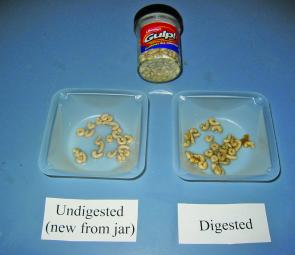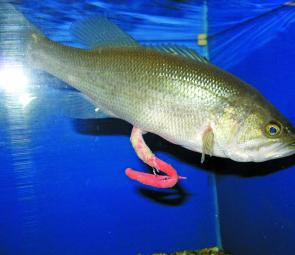There has been a lot of talk about the possible damage soft plastics do to fish and the environment and for many anglers this is a real concern.
Arguably the most popular plastic in Australia at the moment is the Gulp range of products from Berkley. As Gulp is used so much and for so many different species it stands to reason that more Gulp are ingested by fish. But how much damage does Gulp do to fish, if any at all?
This is just the question that the scientists at Berkley in the USA asked themselves so they set about finding out what the retention time was for a variety of their soft plastics. We acknowledge that the species used for testing were not Australian species, but the results do give an insight into what happens when a cheeky snapper, flathead, bass or bream takes off with your plastic’s tail or rips your Gulp from the jighead.
The series of questions following provides some peace of mind to anglers concerned with the side effects of Gulp and PowerBait on fish. The answers are provided by researchers at Berkley.
Through the years we have regularly fed our laboratory bass, bluegills, carp, and trout either PowerBait or Gulp softbaits. Our reasons for feeding the fish softbaits have varied but included the need to test the palatability of new formulas, to verify the safety of our softbait products on fish, to test softbait actions or other attributes, and to demonstrate product effectiveness during customer or consumer shows.
The fish were fed whole baits and/or baits cut into small pieces, either as a single feeding, or repeated feedings over some period of time. In most instances, the fish were fed more Gulp or PowerBait than they ever would normally encounter in the wild. Since these fish were kept in glass aquaria or other holding tanks where they could be readily observed, monitoring the health of the fish used in these instances was relatively easy.
At no time have we ever witnessed any fish exhibit any difficulty in ridding itself of its ingested softbait(s). Small pieces of bait are almost invariably sent through the digestive tract to be expelled within a few days. Larger pieces may be either regurgitated (i.e. vomited), normally within a few hours to a couple of days, or sent through the digestive tract. In the latter cases, the bait is normally defecated anywhere from a few days to 1-2 weeks. The larger and more complicated the bait, the longer it takes for passage through the digestive tract. In one instance, a bass inadvertently took a softbait attached to a whole bass jig (thankfully with the hook bent over). The bass safely regurgitated the bait – complete with the jig – about 3 weeks later.
Recently, we measured just how long it takes for bass and other fish to expel softbaits. In all, we ran four experiments, two on largemouth bass and two on bluegills. In each case we fed the fish whole baits and then observed how long it took the fish to expel the baits, either through regurgitation or defecation. The fish and bait combinations were as follows:
Experiment 1: 20 largemouth bass, each fed one 4” Gulp Earthworm
Experiment 2: 13 largemouth bass, each fed one 6” Gulp Nightcrawler
Experiment 3: 13 bluegills, each fed 1-5 Gulp Maggots (about 1 cm each)
Experiment 4: 13 bluegills, each fed one 4” Gulp Earthworm
For full results of the experiments and details of how each fish ultimately released its bait and the time frame needed for expulsion see the Fact Boxes.
There were only two cases where it took longer than 11 days to recover the baits. These were largemouth bass number 10 and large mouth bass number 15, where each of the fish was fed a 4” Gulp Earthworm in Experiment 1. It took these fish 25 and 24 days, respectively, to expel their baits for the last time. In both cases, bait retention was unexpectedly prolonged due to the tendency of each fish to re-consume its Gulp bait once defecated. Both fish probably first defecated their baits in less than 10 days.
Soft plastic baits, which originated in the US in the 1950s, have been used extensively in a variety of North American freshwater and saltwater fisheries for decades. In freshwater these include largemouth and smallmouth bass, crappie, bluegill, perch, walleye, sauger, rainbow trout, steelhead trout, various species of pacific salmons, brook trout, brown trout, lake trout, stripers, and wipers. The saltwater species are too numerous to list entirely, but major species include redfish, sea trout, flounder, snook, various jacks, bluefish, various snappers and groupers, surf perch, calico and sand bass, lingcod and halibut.
While some populations of a few of these species are suffering for environmental reasons or overfishing, there is no evidence that any of them are being significantly diminished due to softbait fishing. In other words, there is no evidence that any of these populations are suffering from some sort of soft plastic toxicity or any type of physical or physiological damage attributable to softbaits. Indeed, many populations are as robust as they have ever been. As noted earlier by Jim Martin, Pure Fishing’s Conservation Director and a well-respected authority on North American fisheries, “The small amount and size of the soft baits lost from fishing is so minor compared to the size of the (waters) involved as to make them inconsequential.”
As far as the harmful effects on individual fish go, I have read (but have never personally seen the evidence) that some of the phthalate plasticizers used in standard soft plastics may act as estrogen mimics. If true, then these phthalates could potentially serve as “endocrine disrupters”, in essence disturbing the normal gender identification and reproductive patterns of fish. However, while there is definite proof that some substances (most notably the strong synthetic estrogens common to human female contraceptives, i.e. “the pill”) are in fact endocrine disrupters in fish, I know of no evidence directly linking softbait plasticizers to fish hormonal imbalances. Moreover, aside from the potential problems with phthalates, and the occasional fish that consumes an extra large softbait for its size, I know of no other fish health issues associated with softbaits.
Regarding the safety of Gulp specifically, Gulp consists essentially of water, a water-based polymer, organic flavorants, preservatives, and in some cases small amounts of colorant and fleck. Water, of course, is safe, and the water-based polymer is chemically inert, so there is no concern in either case there. All of the flavourants we use as fish attractants are entirely organic and common to biological systems. That is, all of our attractant ingredients consist of substances normally found in living tissue. The preservatives we rely on to maintain product freshness and stability are commonly used in human food or personal health care products. Contrary to rumors and assertions otherwise, the Gulp formula does not include formalin. Again, none of the fish we have ever fed Gulp in the laboratory – despite receiving quantities much higher than they would ever get in the field – have ever exhibited signs of toxicity or any symptoms of physiological/behavioral disturbance (swollen abdomens, intestinal blockage, loss of equilibrium, higher breathing rates, erratic behavior, cessation of feeding, etc.). To date, we have never lost a single fish due to Gulp consumption.
As I detailed in the previous question, Gulp consists principally of water, a water-based, chemically-inert polymer, organic flavourants that serve as fish attractants, and a package of preservatives common to human food or health care products. There is nothing in Gulp that poses a health risk to humans.
Of the thousands of anglers who have used Gulp and consumed their catch (many of the species listed in question #2 are eating fish), we have never received any complaints of flavor contamination by the bait. Nor have we have ever received reports of angler sickness after consuming fish caught on Gulp In short, we have no evidence whatsoever that fish with Gulp inside are any different from fish without. The strong smell of Gulp to humans is exactly that, a strong human smell. It has nothing to do with how fish perceive the bait, since humans and fish do not smell the same chemical spectrums. An angler who cuts open a fish to find Gulp in its stomach has nothing more to fear than an angler who finds the remains of a crawfish or minnow.
Facts
Experiment 1
Species: Largemouth bass (Micropterus salmoides), 17-23 cm Total Length
Bait: Gulp 4” Earthworm
| Bass No. | Days from Consumption to Recovery | Expulsion Means |
|---|---|---|
| LMB1 | 3 | Defecation |
| LMB2 | 1 | Regurgitation |
| LMB3 | 1 | Regurgitation |
| LMB4 | 2 | Regurgitation |
| LMB5 | 2 | Regurgitation |
| LMB6 | 1 | Regurgitation |
| LMB7 | 5 | Defecation |
| LMB8 | 2 | Regurgitation |
| LMB9 | 2 | Regurgitation |
| LMB10 | 25 | Defecation |
| LMB11 | 8 | Defecation |
| LMB12 | 2 | Regurgitation |
| LMB13 | 1 | Regurgitation |
| LMB14 | 1 | Regurgitation |
| LMB15 | 24 | Defecation |
| LMB16 | 2 | Regurgitation |
| LMB17 | 8 | Defecation |
| LMB18 | 1 | Regurgitation |
| LMB19 | 2 | Regurgitation |
| LMB20 | 1 | Regurgitation |
Experiment 2
Species: Largemouth bass (Micropterus salmoides), 17-23 cm Total Length
Bait: Gulp 6” Earthworm
| Bass No. | Days from Consumption to Recovery | Expulsion Means |
|---|---|---|
| LMB1 | 3 | Defecation |
| LMB2 | 5 | Defecation |
| LMB3 | 7 | Defecation |
| LMB4 | 0 | Regurgitation |
| LMB5 | 0 | Regurgitation |
| LMB6 | 5 | Defecation |
| LMB7 | 0 | Regurgitation |
| LMB9 | 11 | Defecation |
| LMB11 | 7 | Defecation |
| LMB12 | 5 | Defecation |
| LMB13 | 0 | Regurgitation |
| LMB14 | 5 | Defecation |
| LMB18 | 0 | Regurgitation |
Experiment 3
Species: Bluegill (Lepomis macrochirus), 10-15 cm Total Length
Bait: Four Gulp 1 cm Maggots
| Bluegill No. | Days from Consumption to Recovery | Expulsion Means |
|---|---|---|
| BG21 | 2 | Defecation |
| BG22 | 6 | Defecation |
| BG23 | 8 | Defecation |
| BG24 | 8 | Defecation |
| BG25 | 6 | Defecation |
| BG26 | 6 | Defecation |
| BG27 | 12 | Defecation |
| BG28 | 4 | Defecation |
| BG29 | 4 | Defecation |
| BG30 | 7 | Defecation |
| BG31 | 7 | Defecation |
| BG32 | 8 | Defecation |
| BG33 | 5 | Defecation |
Experiment 4
Species: Bluegill (Lepomis macrochirus), 10-15 cm Total Length
Bait: Gulp 4” Earthworm
| Bluegill No. | Days from Consumption to Recovery | Expulsion Means |
|---|---|---|
| BG21 | 3 | Defecation |
| BG22 | 3 | Defecation |
| BG23 | 4 | Defecation |
| BG24 | 11 | Defecation |
| BG25 | 3 | Defecation |
| BG26 | 2 | Regurgitation |
| BG27 | 4 | Defecation |
| BG28 | 7 | Defecation |
| BG29 | 2 | Regurgitation |
| BG30 | 2 | Regurgitation |
| BG31 | 2 | Regurgitation |
| BG32 | 3 | Defecation |
| BG33 | 4 | Defecation |

This picture shows there is little difference between these new Maggots and Maggots that have been digested by fish.

A Nightcrawler bait that has been digested by a fish.

Here the fish easily defecates a Gulp softbait, which have not been proven to harm fish in any way.





